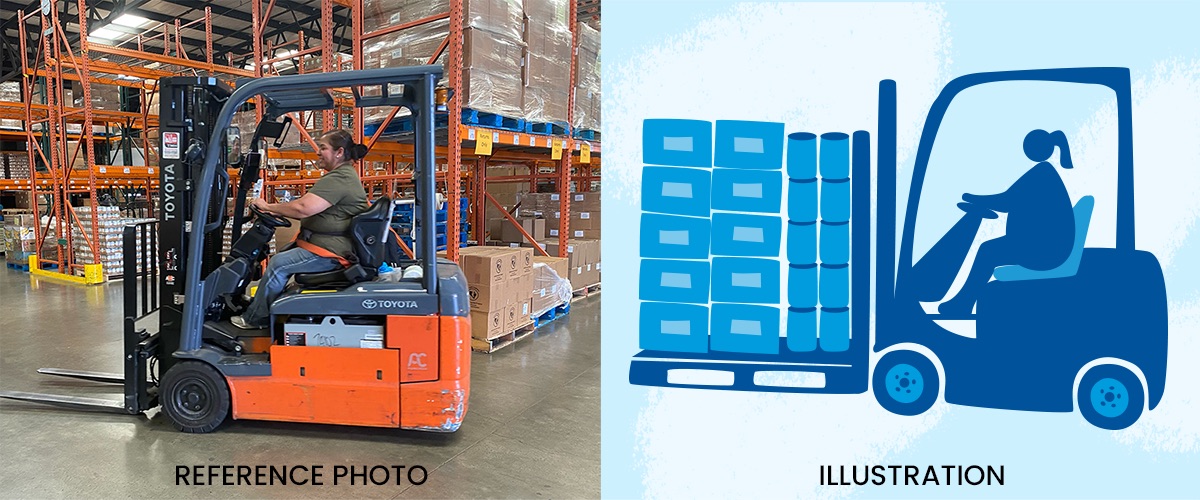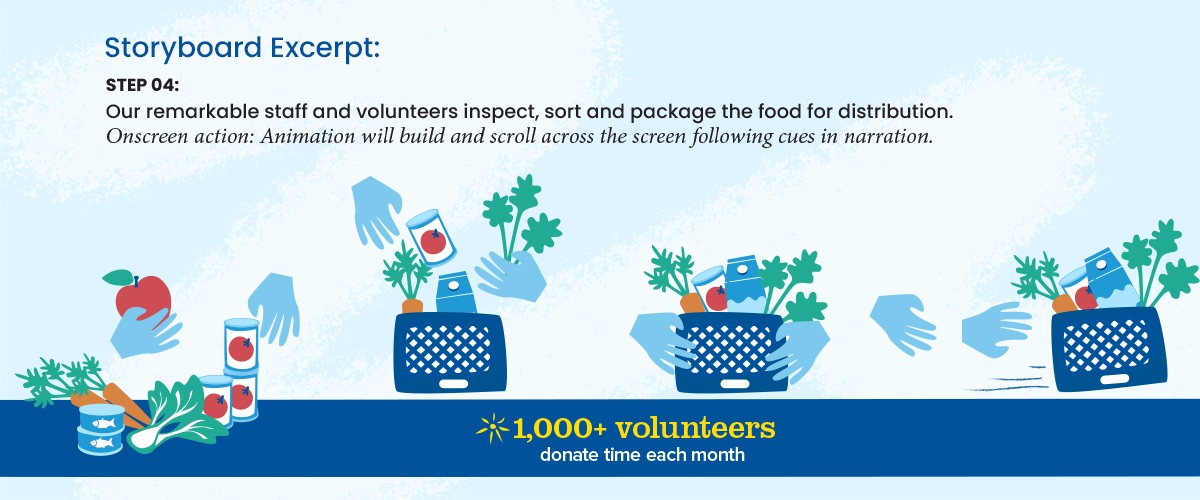Animated Story Production: A Step-by-Step Guide
Have you ever stayed in your seat in the movie theater after an animated feature ends, and the production credits start rolling… and rolling… and rolling? Do you ever wonder what all those directors, writers, illustrators, animators, compositors, and other crew members do?
There is a LOT involved in producing an animated video, even a 2-minute 2D animation. Here is a behind-the-scenes look at how we created an explainer animation for a local non-profit agency.
Sacramento Food Bank & Family Services Explainer Animation
Step One: Initial Meeting and Script Development
Our team met with Kevin Buffalino from Sacramento Food Bank & Family Services (SFBFS) to discuss the goal of the project and identify key points to include in the story. During this meeting, I collected background information, branding materials, and references to storytelling and animation styles that his team found appealing.
Kevin provided a preliminary script, which served as a foundation for our work. Together, we finessed the story so it flowed in an uncluttered, logical way.
Once SFBFS approved the script, we developed a distinct style or ‘look’ for the animation. Kevin gave me a tour of the facilities so I could take reference photos to base my illustrations on. It was very inspiring to see some of the daily processes in real time and to get a first-hand sense of the scale and scope of what they do.
 Reference photo taken at SFBFS facility and an illustration based on it.
Reference photo taken at SFBFS facility and an illustration based on it.
Step Two: Storyboard Creation
The next and arguably the most important step was to create a storyboard. A storyboard utilizes comic book-type panels to show the sequence of onscreen elements and actions that will bring the narration to life. This will define the illustration and typographic style for the final animation.
SFBFS indicated that they wanted a flat-color 2D style for the illustrations. When creating their storyboard, I referenced their brand colors and fonts. I also designed a sequence of key poses or scenes to act as the building blocks for the animated story.
 Excerpt from the storyboard showing how the animated action will progress.
Excerpt from the storyboard showing how the animated action will progress.
During the storyboard phase, I worked with SFBFS to refine details to make the narrative and visuals even leaner and cleaner. SFBFS approved the rock-solid storyboard with the understanding that it would function as the master guide for ALL production steps to follow.
Step Three: Narration Recording
I then sent the polished script to several voiceover artists who recorded audition reads for SFBFS to evaluate. The chosen artist recorded the full narration and sent us a final file to use in the animation compositing process.
Step Four: Preparation of Artwork for Animation
Meanwhile, I fine-tuned the artwork from the storyboard and broke each illustration into many-layered pieces. This step gives the animator the ability to move individual parts of objects, text, and character body parts to create life-like movements.
Step Five: Building the Animation
Once all the artwork was prepped for animation, it was time to begin putting all of the pieces together in After Effects, the compositing program.
- First, I imported static panels from the storyboard and laid them out over the narration track to establish a rough timing for all of the scenes.
- Next, I worked out how the typographic elements were going to enter and exit.
- Then, I went scene by scene and created individual compositions for each object and character and rigged up all the layered pieces so they could be moved fluidly.
- All the scenes were assembled on a master timeline, transitions between each scene were created, background music was added and adjusted to play nicely with the narration and many, many hours later, the story started to gel onscreen.
This rough-cut proof was shown to SFBFS so everyone could see the direction the final animation was taking. Once this cut was approved, the final production work continued until a final polished cut was produced and presented for approval. The final steps were to render a master file and an mp4 optimized for online use and deliver the package to our client. SFBFS placed the video on its website, YouTube, and social channels while also using it as an overview presentation for potential and existing donors.
Check out the final video. We hope you enjoy it as much as we enjoyed making it!
A good story has the power to open a connection to a viewer’s heart. A well-animated story simplifies and abstracts bulky information so it becomes visually appealing and easily digestible, cultivating a desire to learn more or take action.
Uptown Studios specializes in short-form animated videos. We can bring your story to life. View our Vimeo portfolio, see video examples, or get a quote. We’ve got you!
Blog


